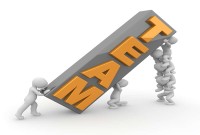- Home
- Business Processes
- Industry Knowledge
- Aerospace Industry
- Automotive Industry
- Banking Domain
- BFSI Industry
- Consumer/ FMCG Industry
- Chemicals Industry
- Engineering & Construction
- Energy Industry
- Education Domain
- Finance Domain
- Hospitality Domain
- Healthcare Industry
- Insurance Domain
- Retail Industry
- Travel and Tourism Domain
- Telecom Industry
- Leadership Skills
- eLearning
- Home
- Leadership
- Creativity Tools
- Characteristics of Leadership
Characteristics of Leadership
There are four characteristics of leadership that help us to understand the character of leadership as a concept. 1. Leadership is a process, 2. Leadership involves influence, 3. Leadership always occurs in a group context and 4. Leadership involves goal attainment. These are the four components that make up the character of the 'leadership' term and help us to define the leadership concept. All of these components of leadership have common characteristics.
1. Leadership is a process
Leadership is defined as a process, whereby individual influences a group of individuals to achieve a common goal. Leadership is a process, not a trait of the leaders but a transactional event that takes place between leader and the led. It affects both the leader and the led in the process of interaction.
As a process, leadership entails perceiving when changes are needed and influencing and facilitating a group's efforts through non-coercive means, to set and achieve group goals. It is not a one-way event, but it is an interactive event. Thus Leadership has three inevitable components -a leader, followers, and a situation.
The relationship between leadership, followership, and the situational and organizational context within which the interactions between leaders and followers occur constitute the leadership process. It is a process which involves relationship and therefore it cannot exist in isolation. Just like the existence of a teacher is meaningless without students, the leadership has no subsistence if there is no follower(s) and a situation.
2. Leadership involves influence
Leadership is defined as the ability to influence a group towards the achievement of a vision or set of goals. To gain followers requires influence and leaders must be able to convince followers to follow his instructions. Influence is an essential condition of leadership. Without the influence, the leadership process itself cannot exist. This moves beyond the position defining the leader, to look at the ability of the leader to influence others, that is, both those who would consider themselves followers, and those outside that circle. Indirectly, it also builds in leadership character, since without maintaining integrity and trustworthiness, the capability to influence will disappear.
Leadership is influencing followers and it is concerned with the way the leader affects his or her followers. Leaders have to influence and direct their followers or subordinates. Therefore, the main function of leadership is to induce or persuade all subordinates or followers to contribute to organized goals in accordance with their maximum capability. While discharging responsibilities, they have to be in constant interaction with' the people with the objective of involving them for collective decision making.
Leadership depends upon the individual qualities of the person and not the office that he holds. Leadership is the term that denotes the behavior or functions of the leader. The leader affects the individual in such a way they surrender themselves and follow his dictates.
3. Leadership occurs in a group context
Leadership always takes place in groups. Leadership involves influencing the group to achieve common goals. Understanding of the leadership is always in the context of the level of the followers and there with the leaders.
Leadership implies the existence of followers. Generally, it is the followers, who determine if the leader is successful by providing their support and accomplishing the needed tasks. Leadership is not about doing things themselves but motivating the followers to work towards business objectives. Here is always an unequal distribution of authority among leaders and group members and commonality of interest between the leader and his followers.
Understanding of the leadership is always in the context of the level of the followers and there with the leaders. Both leaders and followers have involved together with the leadership process. The leaders are in the task of taking initiatives and by which they link themselves with the stakeholders.
If followers do not trust or lack confidence in their leader, then they will be uninspired. To be successful the leader, the leader must know his people, must convince his followers, that he is worthy of being followed.
Understanding these basic individual differences in the followers affects the leadership style and leadership itself. The kind of personality exhibited by the followers in an organization also helps in deciding the style to be adopted. For instance, if employees in an organization prefer a high need for independence, show readiness to assume responsibility, display interest in problem-solving and decision making, then leaders permit greater freedom.
Thus the leadership of a group or organization comprises the direction, impetus, and energy that arises from the circulation of initiatives. An initiative is passed on to the followers who react, respond, and add to circulation, generating their own initiatives.
Throughout the process, there are multiplicities of leaders engaging in actions that comprise this continual circulation.
4. Leadership involves goal attainment
In business, leadership is linked to performance. Those who are viewed as effective leaders are those who increase their company’s bottom lines. These are leaders that understand what the organization wants to achieve, and know how it can be accomplished.
The leader looks into the future and creates new ways in which the organization can prosper. The leader in collaboration with others develops strategies for achieving organizational objectives.
They create networks within the organization to help their groups get work done, and are just as adept at breaking down organizational barriers to progress. The human relations movement, beginning with the Hawthorne studies in the early thirties, focused on the important role of employee motivation and group norms of organizational success. This led to the recognition of leadership effectiveness as an important determinant of organizational effectiveness. The leader appropriately and effectively assigns responsibility and authority. The leader identifies, collects, organizes, and analyses the essential information needed by the organization.
The leader makes timely decisions that are in the best interest of the organization by analyzing all available information, distilling key points, and drawing relevant conclusions. The nature of the task performed in an organization plays a greater role in determining the leadership style. If the nature of the task to be performed in an organization is quite critical and the time is too short in taking decisions, autocratic styles may be used by leaders, whereas in handling the simple tasks with no pressures of time, the leader might adopt a participative style.
The structure of the organization may determine the kind of leadership to be adopted. For instance, some organizations may put a heavy emphasis on the leader’s abilities to work effectively with people. At other times, the social, economic, and political pressures that an organization faces prompt certain styles of leadership to be followed.
Leadership can be summarized as the catalyst that transforms organizational potential into reality. The concept of leadership in itself covers all interpersonal relationships that influence the working of the organization towards achieving its business objectives and growth.
Related Links
You May Also Like
-
Hawthorne Studies - Leadership
The Hawthorne studies were conducted on workers at the Hawthorne plant of the Western Electric Company by Elton Mayo and Fritz Roethlisberger in the 1920s. This study established the behavioral change that happened due to an awareness of being observed, resulting in active compliance with the supposed wishes of researchers, because of special attention received, or positive response to the stimulus being introduced.
-
Teams are part of the modern organizational culture. Whether you are a team leader or a team member, having a better understanding of how teams work, and being able to identify where the team is in the process, is a critical part of ensuring the team is ultimately successful. Start with the basics and understand what a team is and what role they play in an organization.
-
Management theories are the recommended management strategies that enable us to better understand and approach management. Many management frameworks and guidelines were developed during the last four decades.
-
In its simplest sense, decision-making is the act of choosing between two or more courses of action. Decision making is a key skill in the workplace and is particularly important if you want to be an effective leader. When decisions have to be made, there are several stages that you should go through to reach a practical solution. Understand the meaning and importance of decision making and how to look at it as a process.
-
In this study of power, Raven identified five bases of power as coercive, reward, legitimate, referent, and expert. The 5 Types of Power can help you decide when it is appropriate to use a particular type of power in important situations. Leadership involves authority and it is very important for leaders to understand what type of power they're using.
-
Maslow's hierarchy of needs is a motivational theory that explains that people are motivated by five basic categories of human needs. These needs are physiological, safety, love and belonging, esteem, and self-actualization. There is a little scientific basis for this concept of a hierarchy of needs.
-
Team Foundation in Forming Stage
This is the first stage of team development. This is the stage when the foundation of the team is laid. During the Forming stage, team members have a high dependence on their leader for guidance. Learn the practical strategies you can use during this stage to help your team develop into a highly effective performing team.
-
Tools for Developing Your Team
If a manager has too many weak spots in the talent of the team, the ability to empower the team members to independently execute the project is impaired. Assignments fall behind schedule or stretch out because the needed skills or knowledge are not in place when needed. To successfully execute important projects, hiring talented people, and increasing the talents of existing staff are most important.
-
Administrative Theory by Fayol
The administrative theory of management is focused on principles that could be used by managers to coordinate the internal activities of organizations. The most prominent of the administrative theorists was Henri Fayol. Fayol observed a work stoppage and judged it to be a management failure. He believed that organizational managerial practices are important for driving predictability and efficiency in organizations.
-
What are the functions which a leader does to establish as a leader? What are the activities undertaken by them to become great leaders, rather revolutionary leaders? The most important tasks done by a leader in all situations are defining the vision, mission, and goals, leading the team, administrative functions, motivating followers, decision making and conflict resolution, and continuous development.
Explore Our Free Training Articles or
Sign Up to Start With Our eLearning Courses

About Us
Learning
© 2023 TechnoFunc, All Rights Reserved










